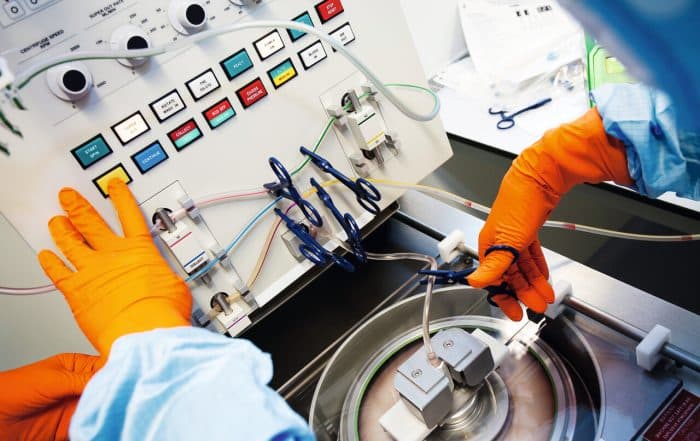Waarom kunnen mensen en machines niet met elkaar opschieten?
"Artificial Intelligence (AI) gaat niet alle banen overnemen. AI zou moeten staan voor 'augmented intelligence', niet voor 'artificial intelligence'. Mensen en machines zijn eigenlijk een perfecte match." Op de 19e editie van het Medical Data + Pizza-evenement betoogde een prominente onderzoeker dat we het vervangingsparadigma resoluut moeten verwerpen als het gaat om AI. En inderdaad, dit idee is - net als pizza - zeer de moeite waard om op te kauwen.
“Het idee dat AI de mens zal imiteren en vervangen, slaat nergens meer op”, zegt hoogleraar Frank van Harmelen van het Hybrid Intelligence Centre. “Alsof je een vierkante pin in een rond gat probeert te persen. Want mensen en computers zijn goed in heel verschillende dingen. Dus waarom zou je de een door de ander vervangen? Natuurlijk is dit geen nieuw idee. Kijk naar elke grote technologische doorbraak: het schrift, de boekdrukkunst, de stoommachine, de computer. Die hebben de mens niet vervangen, maar eerder onze mogelijkheden vergroot. Ze versterkten wat we kunnen doen!”
Zelfs een relatief nuchtere en zakelijk georiënteerde instelling als Deloitte zegt het al jaren: “Het is beter om AI-systemen niet te zien als ‘denkende machines’, maar als cognitieve protheses die mensen kunnen helpen beter te denken en te handelen.”
Van Harmelen sprak tijdens de 19e Medical Data + Pizza op 21 juni 2022 in het indrukwekkende nieuwe NU-gebouw van de VU Amsterdam. De organisator van het evenement, het Amsterdam Medical Data Science (AMDS) netwerk – met meer dan 1.900 leden – bedacht deze bijeenkomst oorspronkelijk als een manier om cupido te spelen tussen datawetenschappers en de medische gemeenschap. Het is nu een beproefde methode: provocerende presentaties, gevolgd door het mengen van beide ‘bloedgroepen’, onder het genot van pizza. Iedereen wint.
Diagnose stroomlijnen
Natuurlijk preekte Van Harmelen vooral voor de bekeerden. In feite weerspiegelde de eerste presentatie van de avond de bestaande wisselwerking tussen mens en datawetenschap bij zowel de ontwikkeling als de inzet van AI-gedreven technologieën in de gezondheidszorg. ‘Automating report generation for chest X-rays and ECGs’ door Ivona Najdenkoska, een promovendus aan het AIM Lab, hield een sterk pleidooi voor een geautomatiseerde manier van het schrijven van rapporten. “Rapporten schrijven is vervelend en tijdrovend”, zei Najdenkoska. “Automatisering verlicht de werklast en verbetert de diagnose in de klinische praktijk. We zouden sneller kunnen reageren op cases waarbij de tijdsdruk hoog is – zoals tijdens de COVID-19 pandemie. Zelfs de meest ervaren radiologen kunnen kleine of zeldzame (maar essentiële) details over het hoofd zien of verkeerd interpreteren.” Kortom, automatisering zou het leven van zowel patiënten als artsen beter en gemakkelijker maken.
Najdenkoska’s onderzoek, dat zich op het snijvlak bevindt van computervisie en natuurlijke taalverwerking, ziet er veelbelovend uit – vooral wanneer menselijke deskundigen de voorgang evalueren.
Geven en nemen: AI als volwaardige partner
Van Harmelen is een voorstander van AI-systemen die samenwerken met mensen in plaats van ze te willen vervangen. Hij is hoogleraar Knowledge Representation & Reasoning aan de faculteit Informatica van de VU, en is vooral bekend als een van de grondleggers van het Semantisch Web, dat tot doel heeft online data ‘leesbaar’ te maken voor machines.
Van Harmelen is ook de belangrijkste initiatiefnemer van het wonderbaarlijk goed gefinancierde Hybrid Intelligence Centre, waaraan onderzoekers van zes Nederlandse universiteiten deelnemen. Zijn onderhoudende presentatie ‘Hybrid Intelligence: Augmenting Human Intellect’ overtuigde velen van de waarde van dit €20 miljoen kostende project. Het is het grootste AI-onderzoeksproject in de Nederlandse wetenschapsgeschiedenis.
Tijdens Medical Data + Pizza schetste Van Harmelen hoe zowel mensen als machines goed zijn in sommige dingen en slecht in andere – en hoe we elkaars zwakke punten kunnen afdekken. “Het basisidee achter het hybride intelligentie concept is dat mensen en computers elkaar kunnen aanvullen.”
Het was bijvoorbeeld een treurige dag voor mensen, toen machines hen begonnen te verslaan met schaken. Een vreugdevolle dag, was toen hybride mens-machine teams die eerste machines begonnen te verslaan. Dit is echt de toekomst, volgens Van Harmelen. Vive la difference!

Werktuigbouwkundige met duurzame landbouwrobot in het veld
We hebben elkaar hard nodig
“Voorspellingen over de vervangingstheorie zijn onbeantwoord gebleven. Elon Musk is in sommige opzichten verbazingwekkend als de rijkste man op aarde, maar hij roept al tien jaar dat autonoom rijden binnen drie jaar een feit is”, zegt Van Harmelen. “Anderen voorspelden dat machines binnenkort de radiologieafdelingen zouden overnemen. Dit imitatie- en vervangingsperspectief heeft geen zin meer.”
Ondertussen heeft de mens AI hard nodig. “We hebben problemen genoeg: wereldwijde pandemieën, vergrijzing, grondstoffenschaarste, instortende biodiversiteit, klimaatverandering, eroderende democratische instellingen. Dit zijn echte problemen waar we behoorlijk slecht mee omgaan, deels vanwege onze cognitieve beperkingen. We zijn ook slecht in waarschijnlijkheden en we verkiezen altijd de korte termijn boven de lange termijn.”
AI heeft op zijn beurt mensen nodig, aldus Van Harmelen. “Hoewel het goed is in eenduidige taken, is AI slecht in generalisaties buiten de trainingsdata – zoals we hebben gezien met gezichtsherkenning die vooral blanke gezichten herkent, of MRI-beelden getraind op een scanner van één leverancier. AI is ook niet goed in normen en waarden, noch in de reden achter, of de context van, de berekening. Dat zijn menselijke sterke punten.”
Maar hoe?
De vraag is nu dus hoe mens en machine optimaal kunnen samenwerken. Wie geïnteresseerd is in de fijne kneepjes van dit punt kan zich verdiepen in de veelgeprezen en goed gelezen paper van het centrum ‘A Research Agenda for Hybrid Intelligence: Augmenting Human Intellect with Collaborative, Adaptive, Responsible and Explainable Artificial Intelligence‘.
Voor Van Harmelen komt de essentie voor samenwerking neer op het delen van doelen. “Jij moet weten waar we samen naartoe gaan. En ik moet weten wat jij weet. En jij moet weten wat ik weet.” Dit wederzijdse bewustzijn van soorten wordt de Theory of Mind (ToM) genoemd. “Zoals onderzoek heeft aangetoond, geven software agents met diepere ToM-niveaus betere ondersteuning aan mensen bij onderhandelingsresultaten.”
Kortom: er zijn nog veel uitdagingen. Maar op dit punt van de avond wordt de ultieme vraag: “Wordt het op een dag mogelijk dat mens en machine samen pizza eten?”
Stay tuned…
Lees ook de verslagen van eerdere Medical Data + Pizza Meet-ups.
De Amsterdam Medical Data Science Group bijeenkomsten worden ondersteund door The Right Data Right Now consortium, dat bestaat uit Amsterdam UMC, OLVG, Vrije Universiteit, Pacmed, Amsterdam Economic Board en Smart Health Amsterdam.
28 juni 2022
Meer weten over
Neem contact op
Blijf jij ook op de hoogte?
8x per jaar nieuws en events uit de regio: schrijf je in voor de Board Update nieuwsbrief
Deel dit artikel
Wil je op de hoogte blijven?
Volg ons dagelijks op LinkedIn en schrijf je in voor de Board Update nieuwsbrief.
Lees ook deze berichten
- Een nieuwe lichting gedreven jongeren is aangetreden bij Young on Board, de ...
- Met de selectie van vier kanshebbers is de regionale voorronde van de ...
- Met meer dan 80 ondernemers, 40 investeerders en diverse dienstverleners bood LSH Capital Match ...





